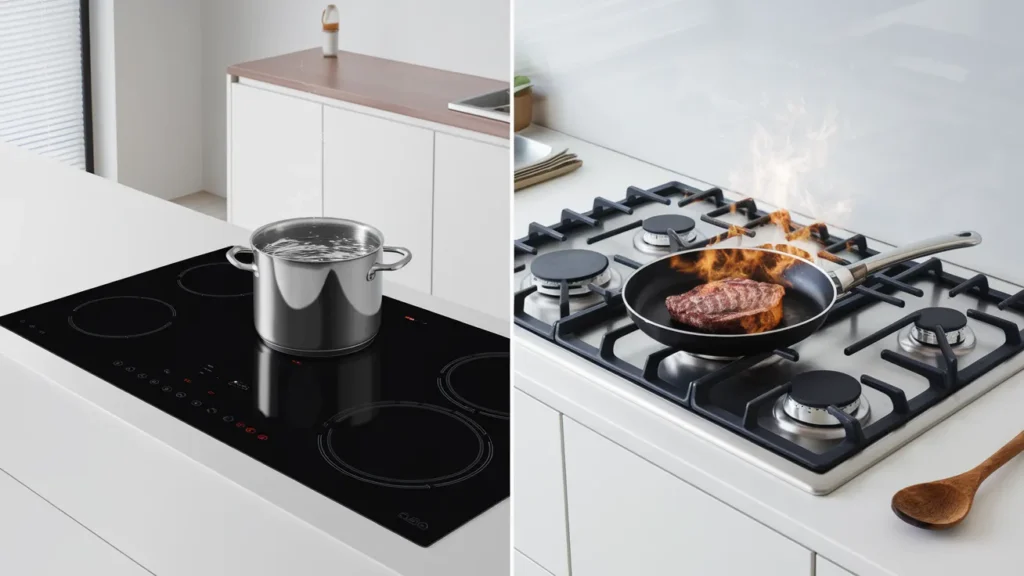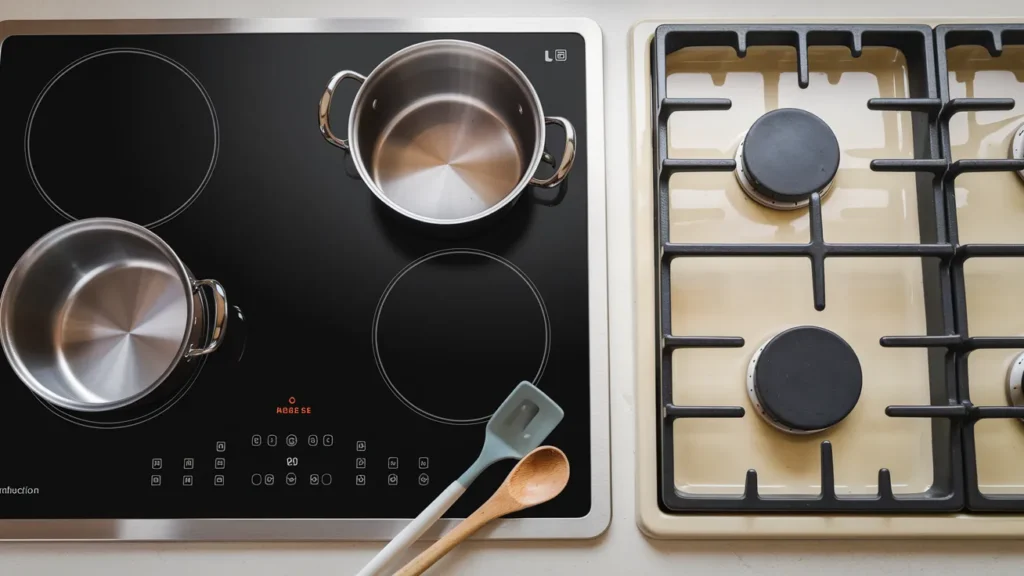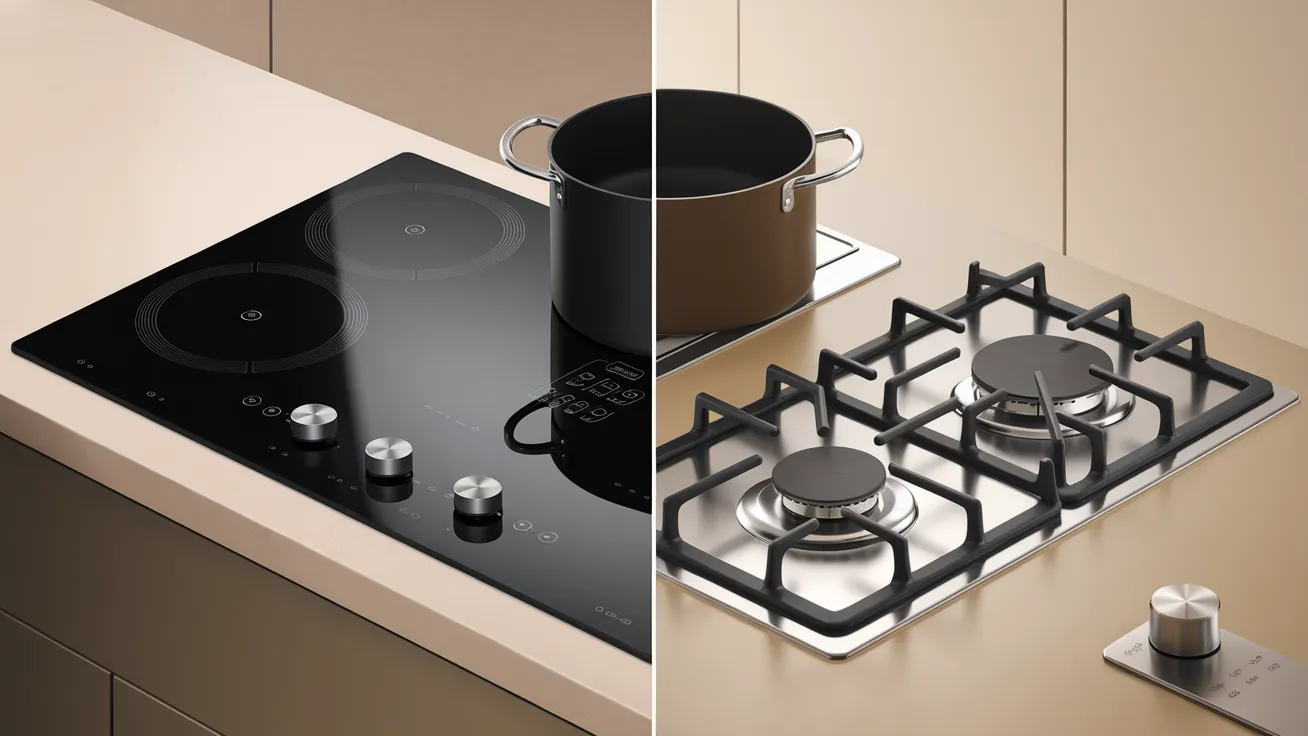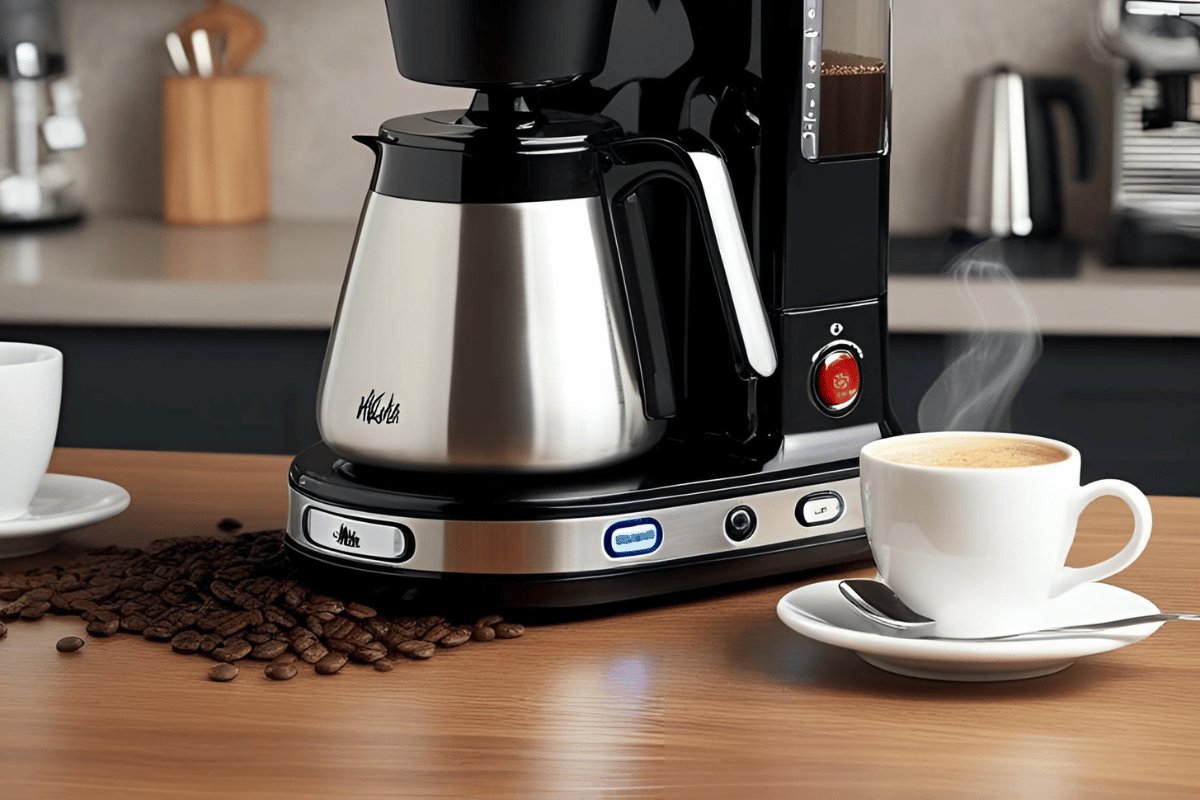When it comes to equipping your kitchen with the right cooking surface, the debate between induction cooktop vs gas has never been more relevant. Both technologies offer distinct advantages that can significantly impact your cooking experience, energy bills, and even your home’s safety. As more homeowners renovate their kitchens, understanding the fundamental differences between induction cooktops vs. gas stoves becomes crucial for making an informed decision.

In this comprehensive comparison, we’ll explore every aspect of the induction cooktop vs gas debate, from cooking performance to energy efficiency, installation requirements, and long-term costs. Whether you’re a professional chef or a home cooking enthusiast, this guide will help you determine which cooking technology better suits your specific needs.
Table of Contents
Understanding the Technologies
How Gas Cooktops Work
Gas cooktops have been the traditional choice for many decades. These systems connect to your home’s natural gas line or a propane tank and produce an open flame when ignited. When comparing gas vs induction cooktop options, it’s worth noting that gas provides immediate, visible heat that many chefs prefer for its responsiveness and familiarity.
The open flame of a gas cooktop allows for visual feedback on heat intensity and offers the versatility to char, flame-grill, or toast directly over the burner—something impossible with other cooking technologies.
How Induction Cooktops Work
In the induction vs gas cooktop comparison, induction represents the newer technology. Rather than using flames or heating elements, induction cooktops employ electromagnetic fields to directly heat your cookware. When you place a compatible pot or pan on an induction cooktop, the magnetic field creates resistance in the cookware itself, generating heat while the cooking surface remains relatively cool.
This fundamental difference in heating method creates many of the distinguishing factors in the induction cooktop vs gas stove debate, particularly regarding efficiency, safety, and cooking precision.
Performance Comparison: Induction Cooktop vs Gas
| Feature | Induction Cooktop | Gas Cooktop |
|---|---|---|
| Heating Speed | Extremely fast; boils water up to 50% faster | Moderate; immediate flame but less efficient heat transfer |
| Energy Efficiency | 85-90% of energy converted to heat | 40-55% of energy converted to heat |
| Temperature Control | Precise digital control, often within 1-2 degrees | Visual flame adjustment, excellent responsiveness |
| Cookware Compatibility | Requires magnetic cookware (iron, steel) | Works with all cookware types |
| Heat Distribution | Even heating across compatible cookware | Concentrated heat at flame contact points |
| Cooking Techniques | Excels at precision cooking; cannot flame-cook | Versatile for all techniques including charring and wok cooking |
Cooking Speed and Efficiency
When evaluating gas vs induction cooktops, cooking speed is a significant factor. Induction cooktops heat pans directly and can bring water to a boil up to 50% faster than gas burners. This efficiency stems from minimal heat loss—nearly 90% of the energy goes directly to heating the cookware.
Gas cooktops, while immediately hot when ignited, lose considerable heat to the surrounding air. In the induction cooktop vs gas cooktop comparison, gas systems typically convert only 40-55% of their energy into heat for cooking, making them less efficient overall.
Temperature Control and Precision
Both technologies offer excellent temperature control, but they do so differently. Gas cooktops provide intuitive visual feedback through flame size, allowing cooks to gauge heat levels at a glance. The immediate response when adjusting the flame is a key advantage in the gas vs induction cooktop debate.
Induction cooktops, however, offer more precise temperature settings with digital controls. Many models can maintain exact temperatures within 1-2 degrees—a level of precision that gas cooktops cannot match. This makes induction particularly valuable for temperature-sensitive cooking techniques like melting chocolate or preparing delicate sauces.
Cookware Compatibility
One crucial consideration in the induction cooktop vs gas stove comparison is cookware compatibility. Gas cooktops work with virtually any type of pot or pan, including copper, aluminum, glass, and ceramic cookware.
Induction cooktops require magnetic-based cookware containing iron or steel. This means some existing cookware collections may not work with induction systems, potentially adding to the overall cost of switching technologies. When weighing induction vs gas cooktop options, this compatibility issue can be a deciding factor for many home cooks.
Installation and Space Considerations
| Feature | Induction Cooktop | Gas Cooktop |
|---|---|---|
| Installation Requirements | 240V electrical connection | Gas line connection |
| Ventilation Needs | Minimal; no combustion products | Substantial; requires good ventilation |
| Counter Space | Flat surface, often thinner profile | Requires space for grates and burners |
| Kitchen Heat | Minimal ambient heat production | Significant heat release into kitchen |
| Under-counter Clearance | Requires space for electronic components | Requires less clearance underneath |
Kitchen Requirements
The installation requirements differ significantly between these cooking technologies. Gas cooktops require a gas line connection, which may not be available in all homes. Installing a new gas line can add considerable expense to your kitchen renovation budget.
Induction cooktops need only an electrical connection, typically requiring a dedicated 240-volt circuit. This simpler installation requirement can make induction a more practical choice in the induction cooktop vs gas debate, especially for homes without existing gas infrastructure.
Ventilation Needs
Gas cooking produces combustion byproducts including carbon monoxide, nitrogen dioxide, and water vapor, necessitating robust ventilation systems. A powerful range hood is essential for gas cooktops to remove these emissions and cooking odors.
Induction cooking generates significantly less ambient heat and no combustion products, potentially reducing ventilation requirements. This difference in heat production also impacts kitchen comfort, especially in warmer climates or during summer months, giving induction an edge in the induction cooktop vs gas cooktop comparison for many homeowners.

Safety Factors: Gas vs Induction Cooktop
| Safety Feature | Induction Cooktop | Gas Cooktop |
|---|---|---|
| Open Flame | No flame; no fire risk | Open flame presents fire hazard |
| Surface Temperature | Cooking surface stays relatively cool | Hot burners and surrounding surfaces |
| Auto Shut-off | Most units turn off when cookware is removed | Manual shut-off required |
| Gas-related Hazards | No gas leaks or carbon monoxide | Potential for gas leaks and CO production |
| Child Safety | Significantly safer for households with children | Requires vigilant supervision with children |
| Power Outage Safety | Stops working during power outages | Continues working (with manual ignition) |
Fire and Burn Risks
Safety considerations often weigh heavily in the induction cooktop vs gas debate. Gas cooktops produce open flames that can ignite nearby flammable materials. The burners and surrounding surfaces also become extremely hot, creating burn hazards, especially in households with children.
Induction cooktops eliminate open flames entirely. Additionally, the cooking surface itself remains relatively cool except for residual heat transferred from the cookware. This significantly reduces burn risks and makes induction a safer option when comparing gas vs induction cooktops for family homes.
Gas-Specific Safety Concerns
Beyond fire risks, gas cooktops present unique safety considerations including potential gas leaks and carbon monoxide production. Modern gas systems include safety features to address these concerns, but they remain inherent risks of the technology.
Induction systems eliminate these gas-specific hazards entirely, which can be a compelling factor in the induction cooktop vs gas stove decision, particularly for those with safety concerns or homes where young children are present.
Cost Analysis: Induction Cooktop vs Gas Cooktop
| Cost Factor | Induction Cooktop | Gas Cooktop |
|---|---|---|
| Initial Purchase | 1,000−1,000−3,500 | 300−300−2,000 |
| Installation | 200−200−500 (electrical work) | 300−300−1,000+ (gas line if needed) |
| Energy Efficiency | 85-90% efficient | 40-55% efficient |
| Operating Costs | Lower despite electricity costs | Higher due to energy inefficiency |
| Cookware Costs | May require new compatible cookware | Works with existing cookware |
| Maintenance | Easy cleaning; potential for expensive repairs | Regular cleaning of grates; simpler repairs |
| Lifespan | 10-15 years | 15-20 years |
Initial Purchase and Installation
When comparing upfront costs, gas cooktops typically have lower purchase prices than comparable induction models. Basic gas cooktops start around 300,whileentry−levelinductionsystemsbegincloserto300,whileentry−levelinductionsystemsbegincloserto1,000.
However, installation costs can reverse this advantage if a gas line needs to be installed. The complete installation of a gas vs induction cooktop can vary dramatically depending on your home’s existing infrastructure.
Energy Efficiency and Operating Costs
The superior energy efficiency of induction technology translates to lower operating costs over time. Induction cooktops convert approximately 85-90% of energy into heat for cooking, while gas systems typically achieve only 40-55% efficiency.
This efficiency difference means that despite potentially higher electricity costs compared to natural gas, induction cooktops often cost less to operate in the long run. When evaluating induction cooktop vs gas options, this ongoing savings can eventually offset the higher initial investment.
Maintenance and Longevity
Both technologies offer excellent durability when properly maintained. Gas cooktops have fewer electronic components that could fail but require regular cleaning of burners and grates to maintain performance.
Induction cooktops feature a smooth glass-ceramic surface that’s easy to clean but can be expensive to repair if cracked or damaged. In the induction vs gas cooktop comparison, maintenance requirements differ in nature rather than in overall burden or cost.
Environmental Impact
| Environmental Factor | Induction Cooktop | Gas Cooktop |
|---|---|---|
| Direct Emissions | None during operation | CO2, CO, NOx during combustion |
| Indoor Air Quality | No impact on indoor air | Can reduce indoor air quality |
| Energy Source | Depends on electricity generation | Direct fossil fuel consumption |
| Resource Efficiency | Highly efficient energy use | Less efficient energy use |
| Carbon Footprint | Lower in areas with clean electricity | Higher due to direct emissions |
Emissions and Carbon Footprint
The environmental implications of the induction cooktop vs gas stove choice extend beyond your kitchen. Gas cooking directly burns fossil fuels and produces carbon dioxide and other emissions during operation.
Induction cooking produces no direct emissions, though its environmental impact depends on your electricity source. In areas with clean electricity generation, induction represents the more environmentally friendly option in the gas vs induction cooktop debate.
Resource Consumption
Beyond emissions, resource efficiency favors induction technology. The higher energy efficiency of induction means less wasted energy regardless of the source. This reduced resource consumption strengthens induction’s position in the induction cooktop vs gas cooktop environmental comparison.
Making Your Decision: Induction Cooktop vs Gas
Ideal Users for Gas Cooktops
Gas cooktops remain the preferred choice for many professional chefs and serious home cooks who value:
- The visual feedback of cooking with flame
- Compatibility with all cookware types
- The ability to char, flame-roast, or wok-cook with direct flame
- Cooking during power outages
- Lower initial equipment costs
Ideal Users for Induction Cooktops
Induction technology appeals to those prioritizing:
- Maximum energy efficiency
- Enhanced safety, especially in homes with children
- Precise temperature control
- Faster cooking times
- Easier cleaning and maintenance
- Reduced kitchen heat
The Verdict on Induction Cooktop vs Gas
The induction cooktop vs gas debate doesn’t have a universal winner—the right choice depends on your specific cooking style, safety concerns, budget, and environmental priorities. Gas cooktops offer traditional control and versatility that many cooks prefer, while induction provides superior efficiency, safety, and precision.
For new construction or major renovations where installation costs are comparable, induction increasingly represents the forward-looking choice in the gas vs induction cooktop comparison. However, for homes with existing gas connections or cooks who specifically value flame cooking, gas cooktops remain an excellent option.
Ultimately, understanding the fundamental differences between induction cooktops vs. gas stoves allows you to make an informed decision that will enhance your cooking experience for years to come. Whether you choose the traditional flame of gas or the cutting-edge efficiency of induction, selecting the technology that best matches your cooking style and priorities will ensure satisfaction with your kitchen’s most important tool.
You may also like: best Modern Kitchen Lighting Fixtures: Illuminate Your Culinary Space
FAQs
Is induction cooking better than gas?
Induction cooking offers superior energy efficiency (85-90% vs 40-55% for gas), faster heating times, and enhanced safety with no open flames or gas emissions. However, gas provides visual flame control, works with all cookware types, and continues functioning during power outages. The “better” option depends on your specific cooking preferences, safety concerns, and kitchen setup.
Do chefs prefer gas or induction cooktops?
Professional chefs have traditionally preferred gas cooktops for their immediate visual feedback, precise flame control, and ability to char or flame-cook foods directly. However, many modern chefs are embracing induction for its superior speed, efficiency, and temperature precision. Restaurant kitchens increasingly use both technologies to leverage their respective strengths.
What are the disadvantages of induction cooktops vs gas stoves?
The main disadvantages of induction cooktops include higher initial cost, compatibility limited to magnetic cookware, dependency on electricity (making them unusable during power outages), and the inability to char or flame-cook foods directly. Some cooks also miss the visual feedback of cooking with flame when switching from gas to induction.
Are induction cooktops cheaper to run than gas?
Yes, induction cooktops are typically cheaper to run than gas due to their superior energy efficiency. Induction systems convert 85-90% of energy into cooking heat, while gas cooktops utilize only 40-55% of their energy for cooking. This efficiency difference usually outweighs the potentially higher cost of electricity compared to natural gas in most regions.
Can you use cast iron on an induction cooktop?
Yes, cast iron cookware works excellently on induction cooktops. Cast iron’s high iron content makes it naturally compatible with induction’s magnetic heating technology. In fact, well-seasoned cast iron pans are among the best performers on induction cooktops, heating evenly and retaining heat effectively.
Is induction cooking safer than gas?
Induction cooking is generally considered safer than gas cooking. Induction eliminates open flames, reduces burn risks with cooler cooking surfaces, produces no combustion byproducts like carbon monoxide, and removes the risk of gas leaks. The cooking surface also cools more quickly after use and automatically shuts off when cookware is removed.
Do induction cooktops use more electricity than gas?
While induction cooktops use electricity rather than gas, they use significantly less total energy due to their efficiency. Induction converts about 85-90% of energy into cooking heat, compared to 40-55% for gas. Even accounting for electricity generation losses, induction typically represents the more energy-efficient and often more economical choice for most households.





